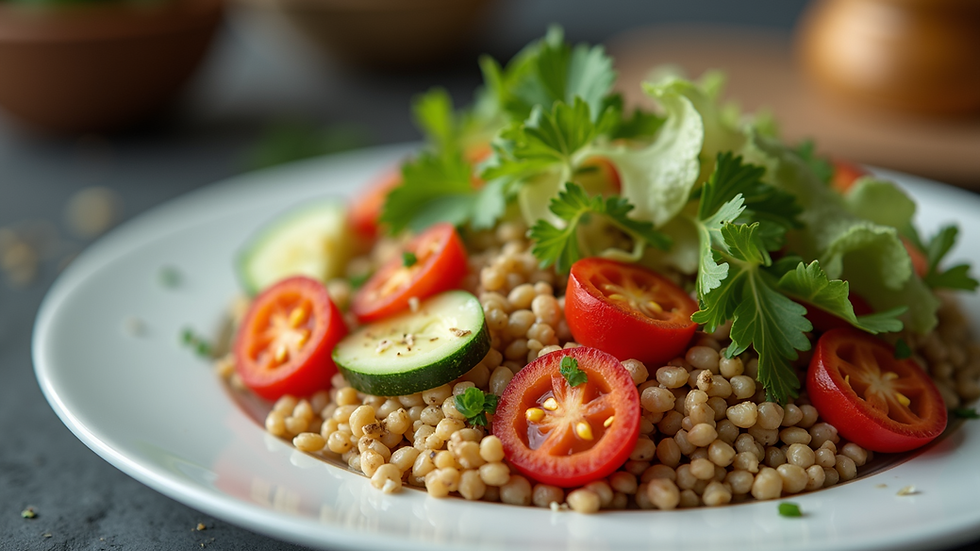Steps to Designing Meal Plans That Fit Your Goals
- Ivona Tarnaj

- Jul 11
- 4 min read
Designing meal plans can seem daunting, but with the right approach, it becomes manageable and enjoyable. Whether your goal is weight loss, muscle gain, or simply maintaining a balanced diet, creating a customized meal plan is essential for reaching your objectives. This guide will walk you through the steps of designing meal plans that fit your specific goals.
Understanding Your Goals in Designing Meal Plans
Before diving into the meal planning process, it's crucial to clearly define your goals. Are you looking to lose weight, build muscle, improve athletic performance, or perhaps maintain a healthy lifestyle? Each goal will require a different approach to nutrition.
For instance, if weight loss is your goal, you may need to create a deficit in your caloric intake. A common statistic is that a deficit of 3,500 calories equates to about 1 pound of fat loss. Conversely, if muscle gain is your focus, your meal plan should include higher protein intake and calorie surplus to support muscle synthesis. Recognizing your specific objectives is the first step towards effective meal planning.

Components of an Effective Meal Plan
When designing meal plans, it's essential to look at different components that will contribute to your overall health. These include macronutrients, micronutrients, and hydration levels.
Macronutrients - These are carbohydrates, proteins, and fats. A balanced meal typically includes all three. For example, a plate with grilled chicken (protein), steamed broccoli (carbohydrates), and olive oil drizzle (healthy fats) makes for a well-rounded meal.
Micronutrients - Vitamins and minerals are equally important. Incorporating a variety of colorful fruits and vegetables ensures your body receives an array of nutrients. Aim for a spectrum of colors on your plate, which often correlates with a variety of nutritional benefits.
Hydration - Many overlook how hydration plays a role in meal planning. The recommended daily water intake is about 2-3 liters, but this varies based on individual needs. Staying hydrated helps in digestion and enhances metabolic processes.

Setting Caloric Needs
Determining how many calories you should consume is a pivotal part of the meal planning process. Various online calculators can help you estimate your daily caloric needs based on age, gender, weight, activity level, and goals.
For instance, a moderately active woman may require around 2,000 calories for maintenance, while a man with a similar activity level might need 2,500. Once you know your baseline, adjust your caloric intake based on your goal.
For weight loss, start with a 500-calorie deficit to lose about 1 pound per week.
For muscle gain, aim for a surplus of around 250 to 500 calories.
Once you have your caloric needs figured out, dividing those calories into meals throughout the day becomes more straightforward.
Creating Balanced Meals
Creating balanced meals is where the real fun begins. To craft successful meals, consider the ratio of macronutrients each plate should contain. A common recommendation is:
40% carbohydrates
30% protein
30% fat
This breakdown can be adjusted to suit individual needs, but it serves as a good framework. Aim for whole-food sources rather than processed foods to maximize nutrients. For example, a balanced lunch might include quinoa (carbohydrates), grilled salmon (protein), and a drizzle of avocado (healthy fats).
When planning meals, think about incorporating meal prep techniques. Cooking in batches can save time and ensure that you have access to the nutritious meals you need, even on your busiest days.

Weekly Meal Planning
Once you’ve defined your goals and established meal components, it's time for the fun part: weekly meal planning! Start by outlining meals for the week, taking into consideration your schedule and the time you have available for cooking.
Choose a Day - Find a specific day of the week that you can devote to planning and prepping. Sunday is popular for many people.
Select Recipes - Choose versatile recipes that can last throughout the week. For example, a large pot of vegetable soup can serve as a base for lunches or dinners.
Make a Shopping List - Once you have your meals selected, create a shopping list. This will not only keep you organized but helps avoid impulse buys at the grocery store.
Prepare for Success - Dedicate a couple of hours on your chosen prep day to cook. Make a habit of prepping snacks, meals, and even sauces to simplify meal assembly during the week.
By following these steps, you create structure while saving time and ensuring you stick to your meal plan.
Adjusting and Optimizing Your Meal Plans
Meal planning should be flexible; you want it to evolve as your needs and preferences change. It might take several iterations of your initial meal plan to find the most satisfying and effective version for you.
Track Your Progress - Keep an eye on how you feel and how your body responds. Are you gaining or losing weight as expected? Are your energy levels consistent?
Stay Flexible - If something isn’t working, don’t hesitate to tweak it. Maybe your protein intake is too high, or you need more carbohydrates for energy. Listen to your body.
Consult Experts - If you're looking for in-depth nutritional advice tailored to you, consider seeking support for creating personalized meal plans. This can provide you with a roadmap that aligns with your specific goals.
By optimizing meal plans based on feedback and outcomes, you create a continuous improvement cycle that maximizes your health and fitness journey.
Embracing Your Unique Journey
Ultimately, designing meal plans that fit your individual goals is about understanding your body, your preferences, and your lifestyle. Everyone's nutritional needs are different—what works for one person might not work for another. By being open to experimentation and adjusting as necessary, you can cultivate a meal planning routine that helps you meet and exceed your health goals.
Remember, this is a journey. Each step you take towards healthier eating helps create sustainable habits that will benefit you in the long run. Whether you are looking for meal planning guidance or inspiration, utilizing resources like personalized meal plans can also support you in reaching your health objectives. Stay motivated, and enjoy the process!



Comments